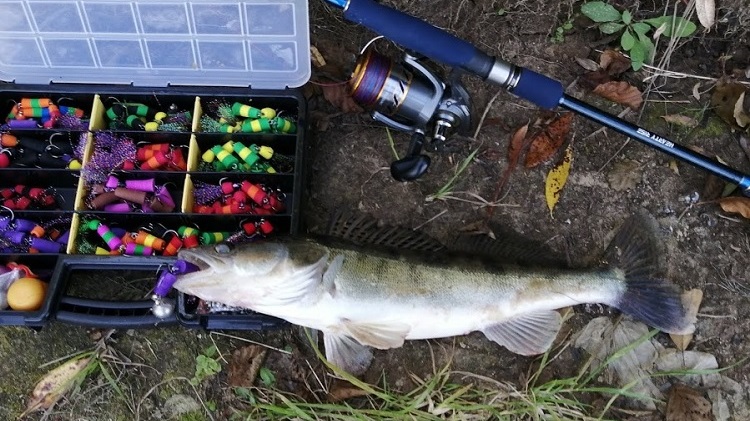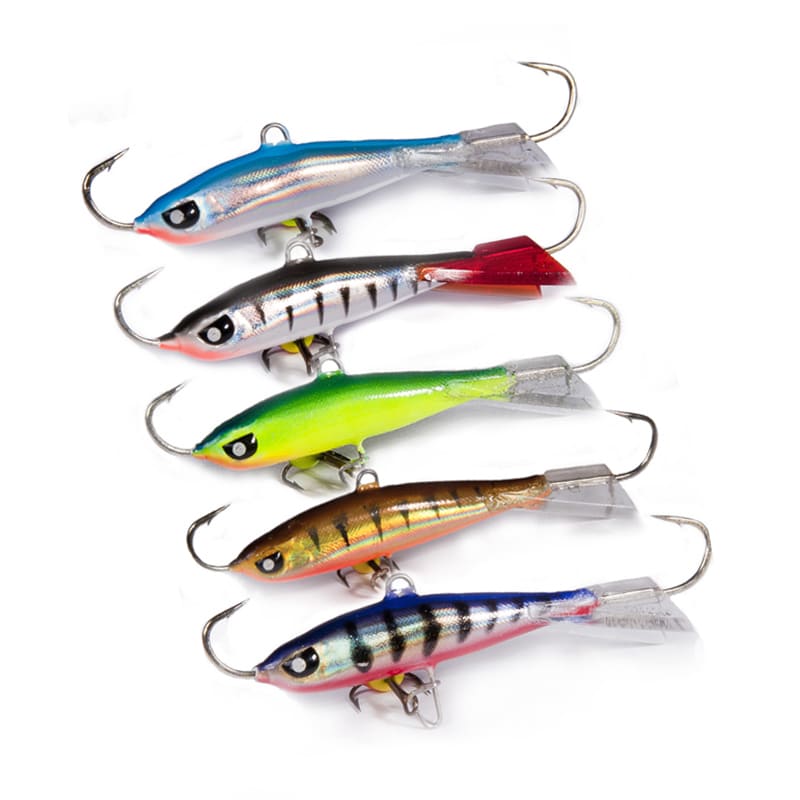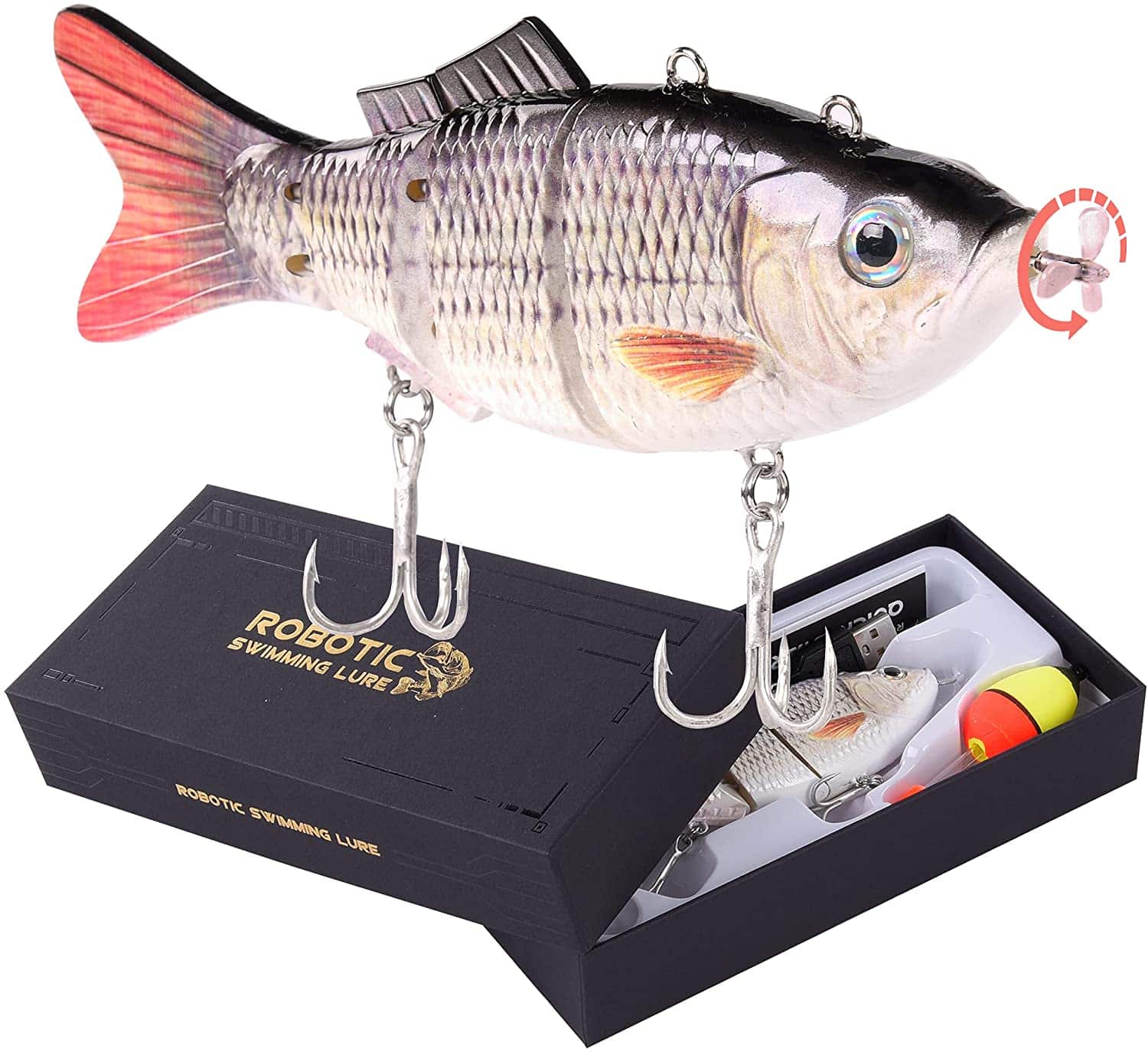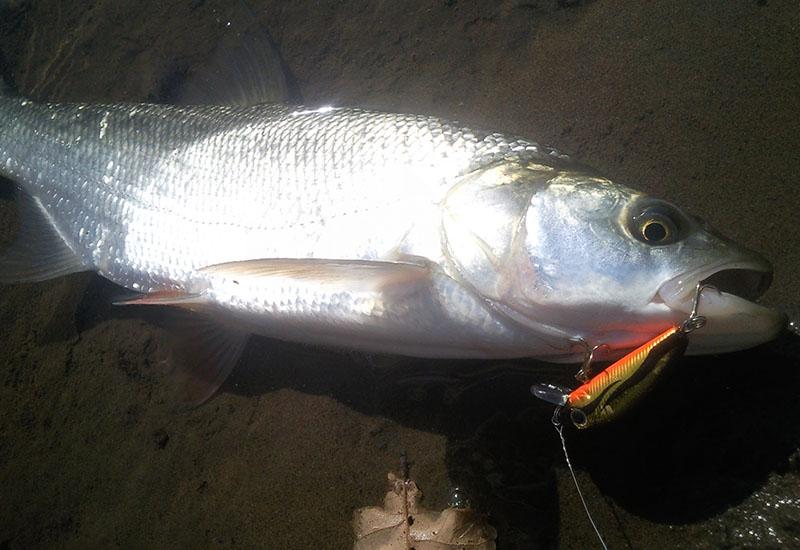For some people, fishing is their favorite pastime. There is a large number of a wide variety of fishing tackles that allow you to successfully fish in different bodies of water, for a certain type of fish, taking into account its habits and taste preferences. Some rigs are used to catch peaceful fish, while others are actively used when fishing for predatory inhabitants of domestic reservoirs. Most modern spinners have heard of a snap bait called mandula. This rig is distinguished by its high catchability rates. Due to active, energetic play with small pauses, during various types of posting, it actively attracts the attention of fish.
In terms of efficiency, the mandula is comparable, and in some cases even surpasses various silicone baits in catchability, which are similar to it in the type of animation and behavior under water.
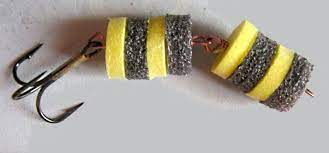
- What is mandula, what is this rig – description and photo of fishing lure
- What kind of fish can you catch on a mandula
- How to make a mandula with your own hands
- Criteria for selecting the size and color of the bait
- Catching on a mandula
- Features of catching predatory fish on mandulas
- Fishing from the coastline and from the boat (spring, summer, autumn)
- How to catch a mandula in a plumb line from a boat
- Ice fishing in winter
- What gear is best to use when fishing with a mandula
- Pros and cons of using bait
- Поделиться ссылкой:
What is mandula, what is this rig – description and photo of fishing lure
Mandula is a popular artificial lure among anglers, which consists of several components with a good level of buoyancy. The elements of this nozzle are usually made of a material such as polyurethane foam. In addition, they can have different geometric shapes. These elements are connected in series, thus forming a one-piece
spinning lure . To connect different parts of this rig, a movable hitch is used, which is carried out thanks to the use of winding rings.
The history of the origin of this fishing equipment is not known for certain. However, there is an opinion that the fishermen of the USSR, trying to make an affordable analogue to ordinary silicone nozzles, invented the mandula, which over time became popular among fishing enthusiasts. According to the dictionary of the Russian language, the term mandula denotes any constructions or parts that do not have an exact official designation or name.
On a note! Mandula is a popular equipment among lovers of not only traditional spinning fishing.
In small sizes, it is perfect for catching trout, crucian carp or such predatory fish as salmon. In addition, this rig can be used as the main attachment for pike fishing. It competes perfectly with a variety of silicone tips. The main difference between the mandula and various lures made of silicone is that its tail part, after being thrown into the water, does not sink to the bottom. During the pauses that the angler makes during the posting, this nozzle remains stationary directly in the water column itself.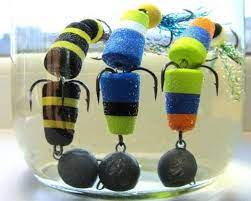
 Mandula for pike perch and pike fishing [/ caption]
Mandula for pike perch and pike fishing [/ caption]
What kind of fish can you catch on a mandula
Initially, mandula was actively used only for catching fish such as
pike perch . However, over time, small changes were made to the design of this rig, making it suitable for fishing a variety of predatory fish. As a rule, this bait is often used to catch the following underwater inhabitants that are found in domestic water bodies:
But the main predator, which likes the mandula, is the pike perch. It is successfully caught on mandula both on small and medium rivers and on large rivers. Volga, on Yauza, Akhtuba, etc.
This tackle is perfect for fishing even in waters where there is little current. Indeed, as a rule, in such areas of the reservoir, with a small, weak current, there is a small fish, fry, which predators hunt. Mandula has a good buoyancy level. After being thrown into the water, thanks to the sinker, it takes a vertical position, thereby imitating the fry feeding at the bottom of the reservoir.
On a note! To adjust the fall of such equipment as mandula, special sinkers are used – heads. To increase the visibility of the bait and enhance the visual effect of its play in the water, a small tail made of shiny material can be attached to the last tee.
The most popular working colors and running models of Mandula lure according to wholesalers: https://youtu.be/rNxSfnYo98o
How to make a mandula with your own hands
Today, every fisherman can easily purchase such equipment as mandula in specialized fishing stores or online stores selling fishing equipment. Among fishermen, author’s mandulas from Vitaly Tarasov, which are sold in almost every online store, are in demand.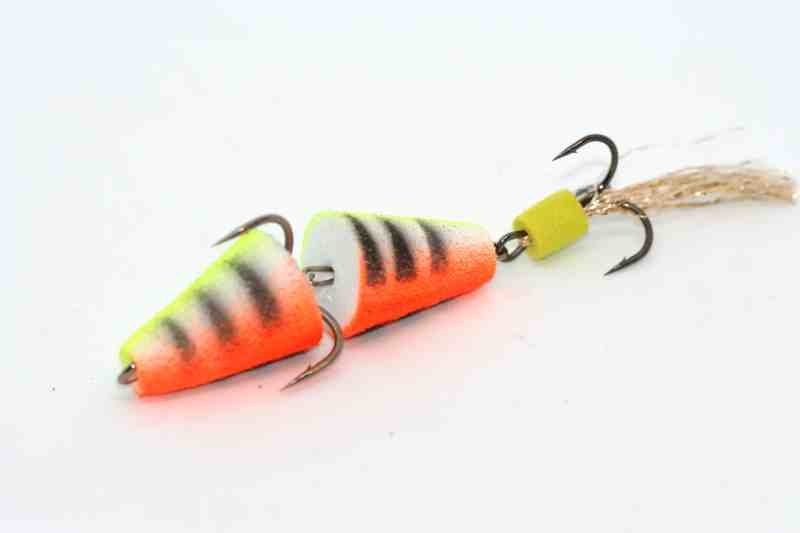
- Polymer. Also, beach slippers, travel rugs and even children’s soft, processable constructors are perfect as a working material. In general, almost any material that has a good buoyancy level can be used.
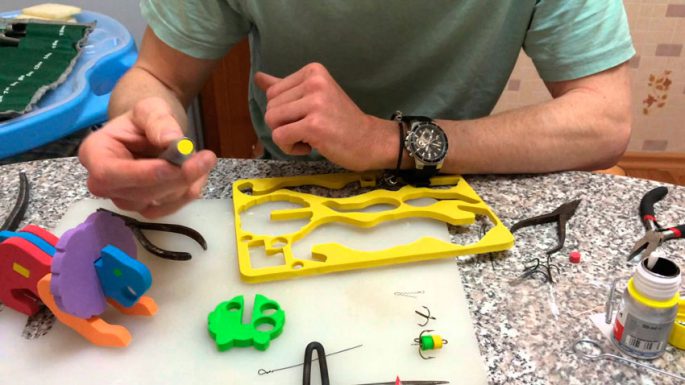
- Tees (you need to stock up on tees of different sizes).
- Lurex (animal hair can be used as an alternative).
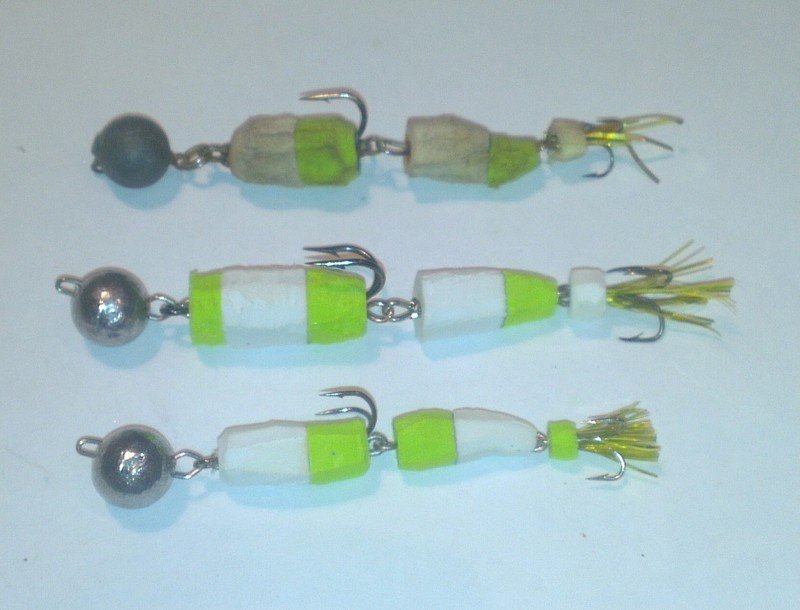
- Clockwork rings.
At the initial stage of making the bait, you need to make blanks from polyurethane. To do this, they are glued to each other, and then give them the desired geometric shape (ball, oval, cone). To do this, you can use scissors or abrasive materials. For example, to round off cylindrical workpieces, they are fixed on the drill of an electric drill, and then, when rotating, they are carefully polished with an abrasive. At the next stage, in the central part of each workpiece, using a red-hot awl, you need to make holes. Then, through the holes, you must carefully thread the wire. At the end of each wire, it is imperative to make a loop into which the winding ring will be threaded. In addition, tees must be placed in the holes made immediately.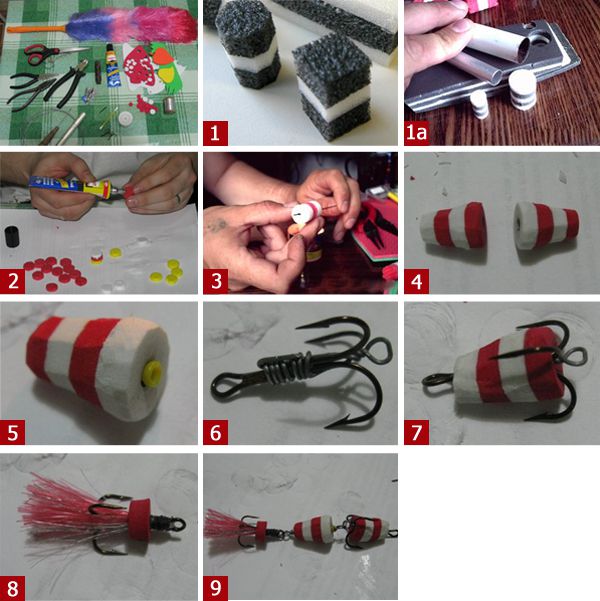
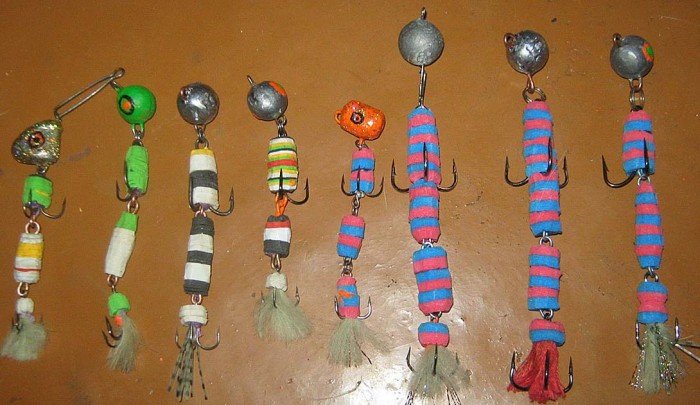
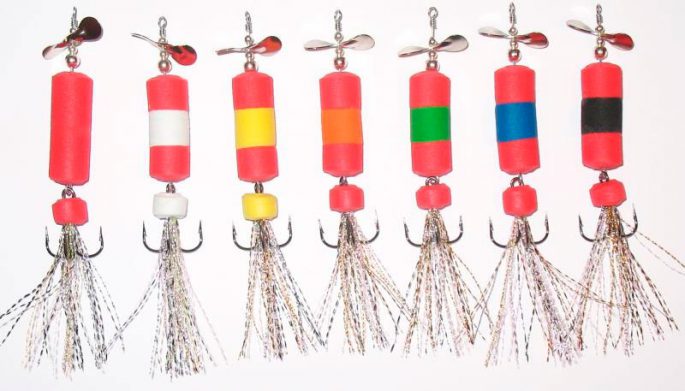
Criteria for selecting the size and color of the bait
Mandula is large, as well as small, small. For catching pike or pike-perch, basically, large rigs are used, the size of which varies from 5 cm to 8 cm. For successful catching of perch, a mandula of small sizes (no more than 5 cm) is used. The size of this rig is influenced by the number, as well as the length of the typesetting elements. The standard mandula diameter ranges from 8 to 12 mm, and the length of one link is 15-25 mm. In the manufacture of this equipment, as a rule, about 2-3 elements are used. In some cases, for catching large fish, such a mandula, consisting of 4 or 5 type-setting elements, can be used.
Important! The number of building blocks has a direct impact on the level as well as the intensity of the play of the rig. As a rule, such a lure, made of 2 or 3 detachable parts, has a more attractive play. It should be noted that the fish prefers small mandulas, the length of which is no more than 5-6 cm.
The vast majority of mandulas are equipped with a tee, or two. This is due to the fact that tees increase the likelihood of successful fishing with bites. However, you must always remember that during casting, tees often cling to the line, and then to the underwater deadwood or grass.
In addition, when installing the mandula, you should always remember that the front hook should be 4 sizes larger than the back one.
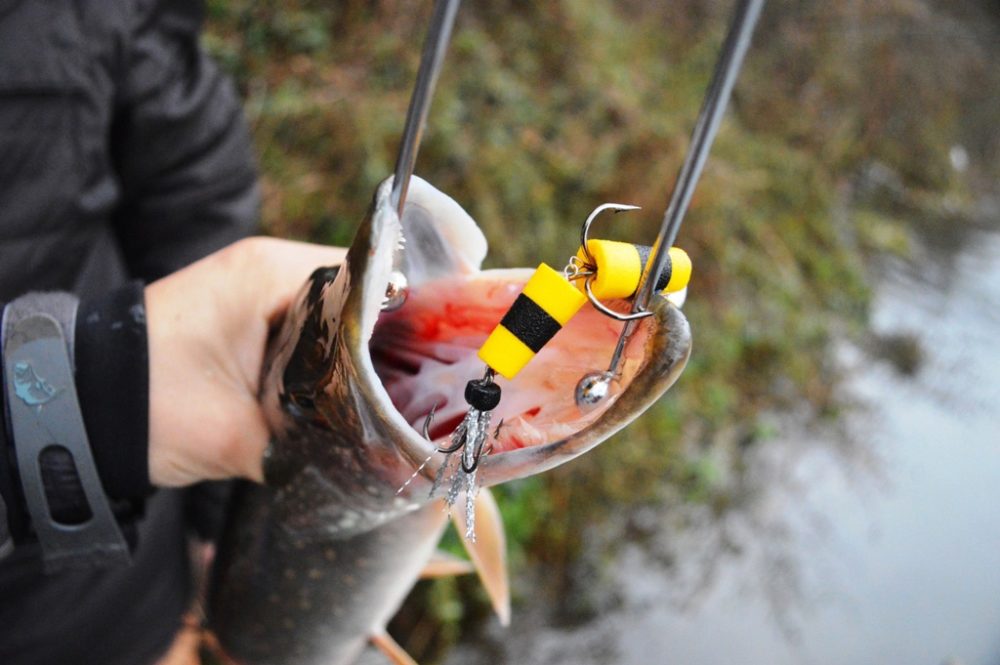
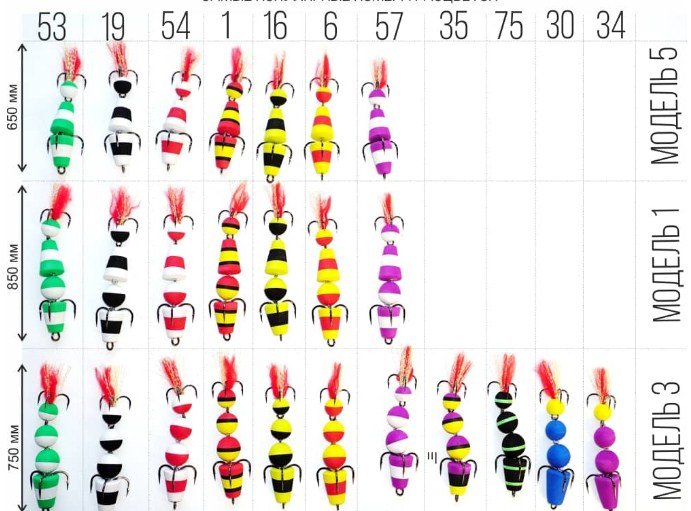
Catching on a mandula
Mandula refers to lures that are used with jig fishing techniques. This rig has a high level of catchability and is almost in no way inferior to spinning lures made of silicone. When fishing from the coastline, the play of the mandula actively attracts the attention of such fish as pike, pike perch, catfish, perch.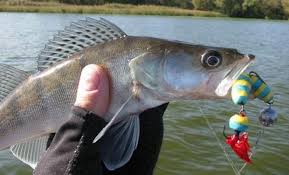
This does not apply to pike. Zubataya prefers slow, measured postings – tossing with pauses, dragging, a lazy step.
In the absence of bites, it is recommended to move to another place in the reservoir and increase the area for casting the bait. To catch pike or perch, you should fish in those places of the reservoir where there are holes or irregularities on the bottom. When using a mandula, the following posting techniques are generally used:
- Jerk.
- Step (this is a classic jigging).
- Drawing.
When fishing in waters where there is a fast current, it is preferable to use a wiring called drag. In addition, in this case, it is recommended to use heavy equipment, the weight of which is from 30 grams.
Features of catching predatory fish on mandulas
Mandula is one of the most catchy lures that are used during the so-called jig fishing. This bait perfectly attracts the attention of predatory fish on its own, however, for its more successful use, several important nuances must be taken into account:
- The use of a mandula when fishing for walleye . In this case, it is best to fish with this rig from a boat. This is because casting the bait from the watercraft will provide a vertical component to the animation. At the same time, to catch zander, you need to make quick casts. When fishing for this fish, you can use simple mandulas or lures equipped with a propeller.
- Fishing for crucian carp . When catching crucian carp with a mandula, use the same technique as when catching a pike perch. However, in this case, you should pay special attention to the colors of the bait used. For a more successful catch of crucian carp, it is recommended to use mandulas, the elements of which are painted with red dots and have black stripes. You also need to reduce the size to 1-2 cm.
- Application of a mandula while fishing for pike . For successful catching of pike, it is recommended to actively use mandulas, consisting of type-setting elements painted in white, yellow and red. It is preferable to use a nozzle, which consists of 3 sections (the total size of the mandula is 7-15 cm). To successfully catch a pike, postings should be carried out with energetic animation (jerks and tosses), but at a slow pace. In addition, when fishing for pike with a mandula, it is recommended to make long pauses after each retrieve (no more than 5 seconds in stagnant water and about 20 seconds in bodies of water with a strong current).
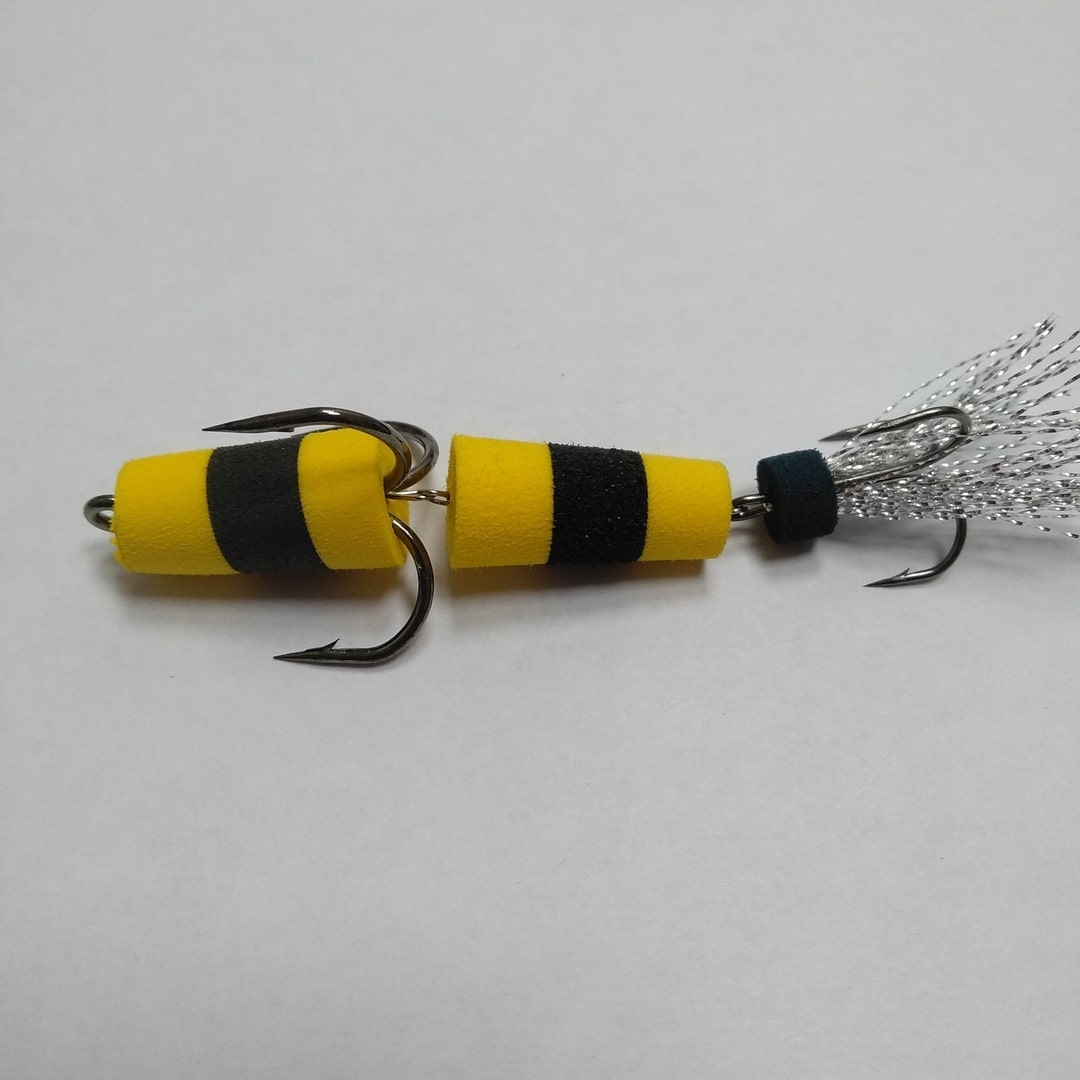
- Fishing for bream . To catch bream, you can use tricolor micromandules. The most acceptable option, in this case, would be the use of bait with a white – red – yellow color, the length of which is from 3 to 6 cm.
Mandula is an excellent indicator for determining the presence of predatory fish in a particular water body. If, while fishing for perch or pike, silicone baits show low efficiency, then in this case it makes sense to use such a composite jig bait.
Fishing from the coastline and from the boat (spring, summer, autumn)
With the beginning of spring, as well as in summer, the fish spends most of their time in pits located at the bottom of reservoirs, or they hide in abundant thickets of underwater vegetation. In light rain or cloudy weather, it is recommended to use baits, which are characterized by active play. At night, it is preferable to use mandulas, which are painted in dark colors. When fishing from the coastline using a mandula, it is recommended to select rods that range in length from 2.5 to 3 meters. In this case, it is preferable to select spinning reels with a high RPM. Casting should be carried out taking into account the speed and strength of the current, as well as the place chosen for fishing, the place on the reservoir. How to fish with a mandula – posting technique, fishing strategy, expert video review: https://youtu.be/coI65pk6mQY
How to catch a mandula in a plumb line from a boat
When fishing from a boat, it is recommended to equip such equipment as mandula with a light, small load. This will ensure its long and smooth descent to the bottom of the reservoir. In addition, when using small loads and with a smooth descent of the tackle into the water, the likelihood of snagging when fishing from a boat is minimized. However, the game of such a rig will not be very energetic and fast. If you tie a large load to the mandula, it will play stronger and more actively provoke predators to bite. In this case, the probability of hooks in this case increases significantly. When fishing from a boat, as a rule, vertical guidance is used, with jerks and periodic pauses. 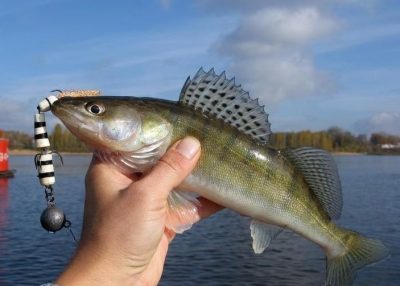
Ice fishing in winter
With the arrival of winter, in order to successfully catch a worthy trophy from the ice, it is recommended to equip the mandula with a sliding weight. At the same time, its mass should allow the rig to freely submerge under a layer of water and, if necessary, quickly break off the bottom. In winter, fish is caught more efficiently and successfully at the moment when the pond is covered by the first ice and during a thaw. In this case, to catch predatory fish, when fishing with a mandula from the ice, it is recommended to use the jerking technique and pick up the rods, the so-called fast action.
What gear is best to use when fishing with a mandula
When fishing with a mandula, it is recommended to use rods with fast or very fast action. The length of the rod can vary from 3 meters (when fishing from the coastline) and from 2 meters (when fishing from a floating device, bridge or pier). It is best to equip a rod with metal leads 15-20 cm long, as well as a thin braid with a diameter of 0.12 mm. For more successful fishing, it is recommended to equip rods with spinning reels. The most acceptable size of the reel used in this case is 2500 – 3000. It is best to select reel models that have a small gear ratio and a friction brake.
Pros and cons of using bait
The mandula has certain advantages and disadvantages compared to the various
spinning lures that are used to catch predatory fish species. The advantages of this nozzle include:
- Low cost . This is an important criterion, since during casts, especially from the coastline, hooks or cliffs often occur.
- Good buoyancy . Perfect for catching sedentary and inactive fish that do not react well to stationary lures.
- Possibility of self-manufacturing of a mandula at home. The article and the Internet describe a large number of different ways to properly assemble and equip the mandula.
- Possesses great efficiency when used in cold weather or in winter, on non-freezing water bodies.
- You can choose the size yourself (depending on the size of the fish you are fishing and fishing conditions).
In addition, mandula has a high level of catchability, it hooks fish well. Also, compared to silicone baits, when using a mandula in offset, there is a much smaller number of hooks. However, this rig has one drawback – it constantly, during slow postings, actively collects various debris and algae from the bottom of the reservoir.
That is, the mandula, in dry residue, should be used for an active and passive predator, in relatively clean areas of water bodies, since, in addition to catchability, it cuts well not only a predator, but also underwater snags and debris.
